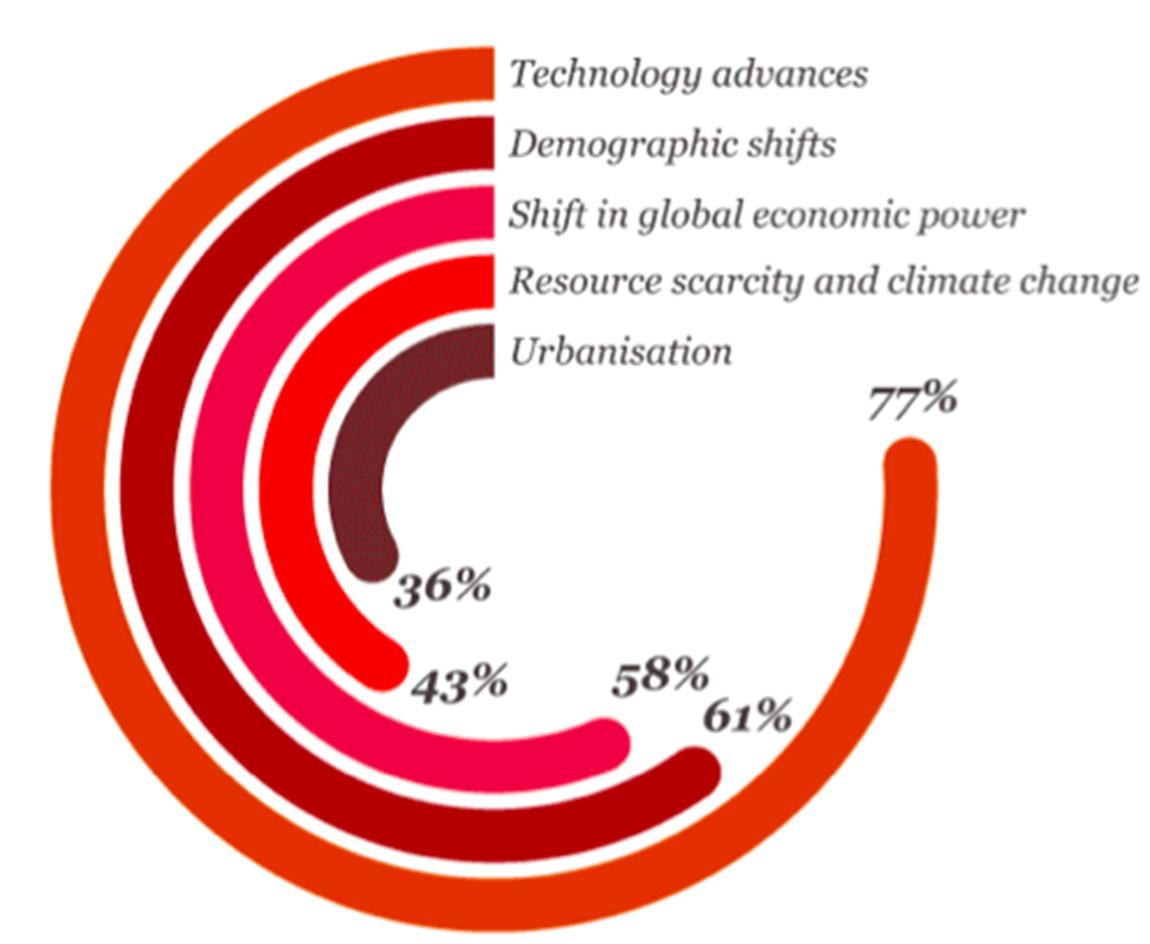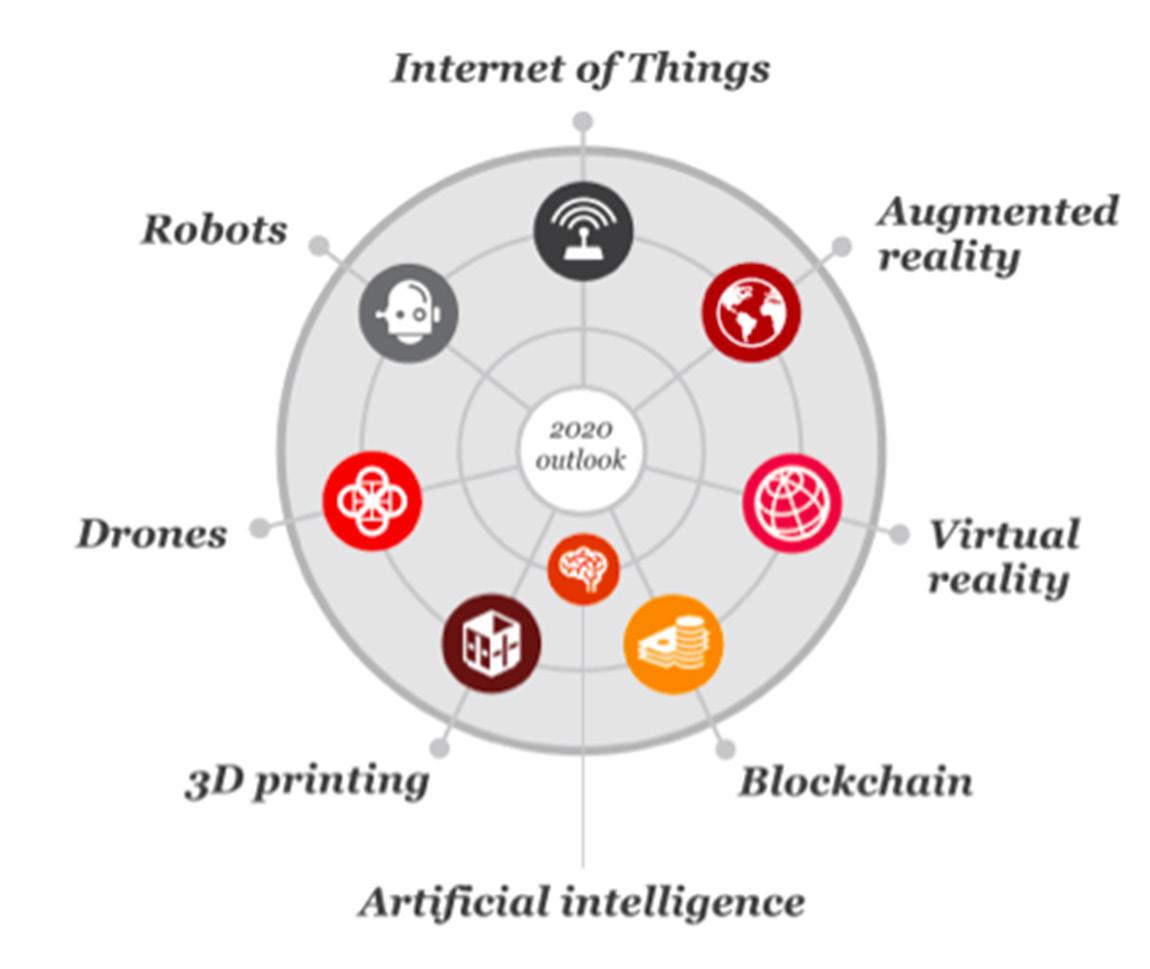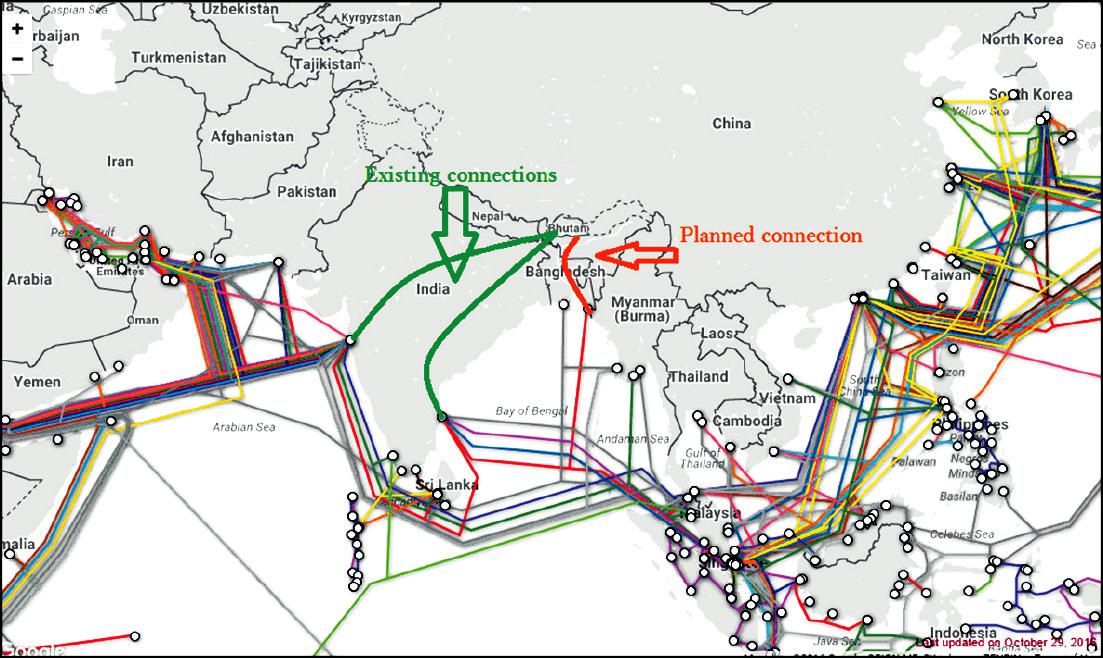The so-called Industrial Revolution 4.0 has arrived and it is being driven by advances in technology, such as artificial intelligence, Internet of Things, blockchain, virtual reality, augmented reality, 3D printing, robots and drones. The trend shows that we will be able to create systems and robots which are as smart as, or smarter, than humans. Using big data, Artificial Intellegence (AI) will be capable of analysing massive amounts of information and come up with amazing solutions to various problems. This portends a revolution that will be far more disruptive and unpredictable than all the industrial revolutions of the past. It would affect us as individuals and as a country. How prepared is Bhutan for the oncoming disruptions? Will we be prepared enough to take advantage of the opportunities that come with it, or will we be caught by surprise and lose more than we gain?

Figure 1. The top global trends which CEOs believe will transform their business over the next five years (Source: : https://www.pwc.com/gx/en/issues/technology/tech-breakthroughs-megatrend.html)

Figure 2. The eight essential technologies that would drive the future (Source: https://www.pwc.com/gx/en/issues/technology/tech-breakthroughs-megatrend.html)
Since we started on our modern development journey only in 1961 with the start of the first Five-Year Plan, we were able to catch the ICT revolution bandwagon rather late. We opened ourselves up to the Internet and Television only in 1999. By then, India, for instance, was already reaping the benefits of economic liberalisation initiated in 1991, and their IT/ITES sector was taking off in a big way.
We have no doubt come a long way since 1999, but we are still very much a population of passive consumers of technology, mostly hooked to social media like Facebook and WeChat, rather than producers of content or developers of applications. It is often touted that Bhutan has the advantage of jumping directly to the information age without the baggage of the industrial age, but are we doing enough to turn that advantage to our benefit? Are we doing enough to use the opportunities that the new technologies offer, to catch up with the rest of the world? What is our IT or digital strategy? Or are we simply too absorbed in our business as usual-with our focus on hydropower, agriculture and tourism-to harness the opportunities that the emerging technologies offer?
What Other Countries are Doing
Singapore is a world leader when it comes to digital transformation and its preparedness for the future. It is ranked No 1 on IMD World Digital Competitiveness Ranking 2017, as well as No 1 on Asian Digital Transformation Index 2017. Singapore has one of the most progressive ICT policies and regulatory frameworks in the world, a conducive business environment ranked No 1 consistently on World Bank’s ease of doing business index, strong STEM (science, technology, engineering and math) education, and it scores high in international technology transfer and firm level technology absorption. Thailand is at 41 and India at 51 on the IMD World Digital Competitiveness Ranking 2017. Bangladesh and Bhutan are not even covered by the study. “The newly instituted IMD World Digital Competitiveness Ranking measures a country’s ability to adopt and explore digital technologies leading to transformation in government practices, business models and society in general”, the study notes.

Figure 3. Digital competitiveness model
Source: IMD World Digital Competitiveness Ranking 2017.
Many developing countries have also recognised the fact that they cannot avoid the impact that these rapid advances in technology would have on their people, and have initiated plans and programmes to take advantage of these technologies for their socio-economic development. India has a Digital India initiative, which is one of the most ambitious projects of the Government of India. It is part of Prime Minister Narendra Modi’s vision of making India a “digitally empowered knowledge economy”. Besides successful e-Government projects, e-commerce and mobile payments are fast picking up in India. According to a report by investment banking firm Credit Suisse, entry of global players into India’s digital payment space is expected to grow the segment by about five-fold, to USD 1 trillion by 2023.
Digital Bangladesh is a big all-encompassing project under the leadership of Prime Minister Sheikh Hasina that has had a huge impact on public service delivery, as well as the development of IT and IT-enabled services (ITES) as an industry. In Thailand, the Ministry of Information and Communication Technology was re-named as the Ministry of Digital Economy and Society, and has initiated various plans and programmes to bring Thailand on board the fourth industrial revolution.
The above are just few examples. Many other developing countries have their own digital strategies and initiatives. In contrast, Bhutan’s ICT initiatives so far have been lacklustre. The “ICT-enabled knowledge-based society” has remained just a vision without many practical plans and programmes, like Digital Bangladesh has, for instance. We cannot prepare for the future by continuing to bank only on agriculture, hydropower and tourism. These three sectors are important for Bhutan, but if we are to catch up with the rest of the world, we also have to recognise and bank on the technologies of the future. Otherwise, there will be no use crying over spilt milk some years down the line.
IT for Innovation and Entrepreneurship
IT opens up a lot of economic opportunities for a landlocked country. We can have digital start-ups capturing markets beyond Bhutan. For instance, Headspace, an app that provides guided meditation, has gained millions of users worldwide and was valued at US dollars 250 million (M) (about Nu 7.5 billion) in 2017. Then there are a host of other meditation apps, such as Calm, Buddhify 2, etc, which are also doing well. Such an app could well have been started by a Bhutanese, given our living tradition of Buddhism.
Another disruptive start-up, airbnb.com, that even Bhutanese house owners use to let out their extra rooms and apartments, is valued at USD 31 billion, equivalent to about Nu 2,170 billion (B). That is over ten times our 11th Five-Year Plan budget, which was Nu 213B. The point of giving these examples is that the digital era that we live in offers such opportunities. It is not a far-fetched dream to hope for a Bhutanese youth to come up with a business idea that would become big and go global. Our Bhutanese version of taxi-hailing apps, such as MyDrukRide and Oie, are signs of things to come. Elsewhere in Asia, many new start-ups in areas such as Fintech and health are raising millions of dollars in investments. With a better enabling environment and encouragement from all stakeholders, our youth too would shine.
So far, our IT businesses have failed to scale up, though they are sustaining as small or medium firms. Almost all our domestic IT firms have not been able to grow beyond 20-30 people. Why is this so? Is it because of our procurement system, which has encouraged our so-called IT companies to be mere fronts and commission agents for companies from across the border? How can we ensure that our works are given to domestic companies, to encourage them to get more experience, grow and go global? These are some of the questions that we need to ponder over on a more practical level, in addition to dreaming big for the future.
Employment Creation
Besides employment creation through new IT businesses, IT also enables our youth to work as online freelancers on platforms such as upwork.com, fiverr, etc, or work directly for foreign companies, from anywhere in Bhutan as long as you have a good Internet connection. No youth who is good at programming or website development would remain unemployed today.
The first IT Park has also shown that Bhutan can attract Foreign Direct Investment (FDI) companies in the IT/ITES sector to help create employment opportunities for our youth. Currently, around 700 Bhutanese youth are employed in the eight FDI companies and domestic start-ups located at the IT Park, despite the fact that the IT Park is neither recognised as a Special Economic Zone, nor promoted wholeheartedly as one of the solutions for rising youth unemployment.
We can achieve more if we embrace FDI in IT/ITES sector wholeheartedly as one of the solutions to youth unemployment, and go all out to market Bhutan as an investment destination. Right now, our approach is half-hearted at best. FDI in IT/ITES sector has minimal negative impact on our environment and culture. They help create much-needed jobs for our youth, at much lower cost and risks than sending our young boys and girls to other countries through the Labour Ministry’s Overseas Employment Programme. Yet, we have not had the courage to give “Special Economic Zone” status to the IT Park, or provide one-window service and special incentives to investors. Currently, the companies located at the IT Park do not enjoy any special benefits as additional incentives over companies located outside the IT Park. The current approach lacks the clarity, drive, and vision needed to give confidence to investors, and take employment creation in the IT/ITES sector to the next level. This gives a feeling that we do not have a clear vision about what we want to do to create jobs or develop the IT sector.
e-Governance
With the G2C initiative that began in 2010, the government has put in efforts to take delivery of public services online, with the primary focus of reducing turnaround time, enhancing accessibility, and strengthening accountability. As of today, a number of government services can be accessed online, but challenges remain. The online tax filing, application for security clearance, and audit clearance are some of the most used and successful e-Government applications. Some online services are not used, either because of system problems, or lack of commitment from the serving agencies to make it work.
For an e-Government application to be widely adopted and used, the single most important factor is the willingness and the commitment of the agencies involved to make it work. For instance, the online audit clearance system would fail if the concerned officials in Royal Audit Authority do not verify and respond to the requests on time. E-Government systems have made public service delivery more efficient and transparent all around the world. We need to do better than what we have done so far. We have to make the applications more user-friendly, reliable, robust and secure, enable mobile access and online payments etc, and ensure that the government agencies are seriously committed to taking their services online as much as possible.
Improving Connectivity
The demand for increased bandwidth will continue to grow with the growth in mobile services and adoption of smart phones. Internet access is no more a luxury but a necessity, even for our rural folks. There is an increasing recognition in the international community that “Access to the Internet” should be considered a basic human right. Reliable Internet connectivity is also key to the success of e-Government systems and attracting FDI in the IT/ITES sector, including the location of data centres.
In order to improve the reliability of our Internet connectivity, we have to improve the redundancy of our Internet backbone infrastructure. Currently, there are two locations from where fibre optic cables connect Bhutan to the outside world. They are Phuentsholing and Gelephu. However, both these routes pass through the narrow Siliguri corridor in India. In order to resolve the issue of redundancy requirements for Internet backbone connectivity, the Royal Government of Bhutan has been exploring the option of getting a connection to Bangladesh through India, connecting to the submarine cable landing station at Cox’s Bazaar in Bangladesh. The rough route for this planned connection is shown in orange in Figure 3.
Given the importance of reliable Internet connectivity for Bhutan in this digital era, it is of paramount importance for our government to follow through and get the new connection from Cox’s Bazaar at the earliest. This could be an initiative for the new government.

Figure 3. Map showing possible connection through Cox’s Bazaar in Bangladesh to SEA-ME-WE-4 Submarine Communications Cable (Source: Submarine cable map from www.submarinecablemap.com ).
Preparing for the Future
At every stage of our progress as a human society on this planet, the major changes in the way we live have been brought about by technological revolutions, starting from the agricultural revolution and the industrial revolution of the 18th century. History has shown that the countries that lead are the ones that lead in these new technologies. So it is a no-brainer that Bhutan has to keep abreast of the new emerging technologies if we do not want to be left behind. That is why China’s 2030 plan envisions building a USD 1 trillion AI industry, and it is determined to dominate the AI space in the future.
Our policy makers should analyse how the advances in new technologies like artificial intelligence, blockchain, cryptocurrencies, etc, would affect us. Our policies, plans and programmes should be aligned with these new advances in technology because we cannot escape their impact, whether we like it or not. Most of all, we need to prepare our next generation for a different world that would be shaped by these new technologies. According to futurist Gerd Leonhard, our world would change more in the next 20 years than it has in the past 300 years. We would need to remodel our education system to prepare our youth for the kind of world they would live in. Our children should be given opportunities to learn not only IT skills, but also basic programming skills, right from high school level.
Conclusion
Gross National Happiness is great as a guiding philosophy, but it would be good to reflect on what exactly is our country’s economic vision. How can we achieve self-reliance? Is it only hydropower, agriculture and tourism? Are we doing enough to harness the opportunities that new advances in technologies have to offer? What is our Digital Bhutan strategy? What are the plans and programmes that would enable us to achieve tangible results under that strategy? What is our FDI strategy? Do we want to get more international IT/ITES companies to come in to create jobs? If so, how are we doing enough to attract them? Half-hearted approaches are seldom enough.
Recent focus on entrepreneurship and SMEs is laudable, but we need to think bigger. Our market size is too small. We need to nurture some of our SMEs to become big businesses that can enter the global market. IT can definitely enable this. A Bhutanese youth’s idea could spawn a future digital unicorn valued at billions of dollars.
In the past, Bhutan did well by being very cautious in its approach-watching and taking the time to decide. In the current situation, where the pace of developments is much faster, we have to be more prepared and agile.
Annexure
Background on Developments in ICT in Bhutan
Following the launch of the 1st Five-Year Plan in 1961 under the visionary leadership of the Third Druk Gyalpo, His Majesty Jigme Dorji Wangchuck, the first rudimentary telecommunications system using the open wire carrier system was set up in Bhutan, with India’s assistance through Project Dantak in 1963. Thimphu was connected to Phuentsholing in the west, Trongsa was connected to Gelephu in the centre, and Trashigang was connected to Samdrup Jongkhar in the east. However, there were no interconnections between the three networks within Bhutan.
In 1970, the Royal Government of Bhutan established the Ministry of Communications with two departments: The Department of Telecommunications and the Department of Civil Wireless. In 1984, an analogue microwave link between Thimphu and Hashimara in India was set up. After having deployed the basic infrastructures for telecommunications, Project DANTAK handed over the telephone exchanges to the Royal Government of Bhutan in December 1984.
Bhutan’s first modern telecommunications network connecting all the major towns of Bhutan was established with the implementation of the National Telecommunications Development Plan (NTDP) between 1991 and 1998 with assistance from Japan. When the NTDP implementation was completed in June 1998, Bhutan had for the first time a national telecommunications network that linked together the head offices of all the 20 dzongkhags.
The Internet and television were introduced in Bhutan for the first time on 2 June 1999, coinciding with the Silver Jubilee celebration of the golden reign of His Majesty The Fourth Druk Gyalpo. To ensure effective and efficient telecommunication services delivery, the Department of Telecommunications was transformed into a state-owned corporation, Bhutan Telecom Limited (BTL), in July 2000.
BTL successfully introduced the cellular phone services for the first time in Bhutan in November 2003 under the brand name ‘BMobile’. With the aim of liberalising the market and allowing healthy competition, the government licensed Tashi InfoComm Limited (TICL) on 6 October 2006, as Bhutan‘s first private mobile operator, though a competitive bidding process. Presently, BTL and TCL have coverage of all the dzongkhags and almost all the villages of Bhutan. The Government has provided financial subsidies to the two operators through the “Rural GSM Project”, to take mobile coverage to the remote villages, where it is not commercially feasible for the operators to do so on their own.
Under the ongoing National Broadband Master Plan Implementation Project, the Government has connected all the 20 dzongkhags and 200 out of 205 gewogs through fibre optic cables (using the optical ground wire (OPGW) in overhead transmission lines or using transmission towers to support a separate All-Dielectric Self-Supporting (ADSS) fibre cable with no conductive elements). These fibres are leased to telecom operators at free of cost. In addition, the government has built Community Centres in 200 of the 205 gewogs for information access and service delivery.
The government also successfully completed a Nu 2B ICT capacity building project called Chiphen Rigpel at the end of 2015 with assistance from the Government of India.